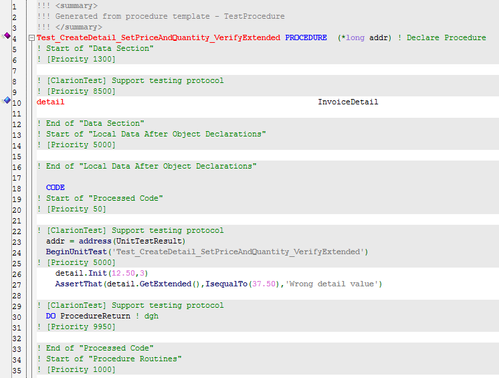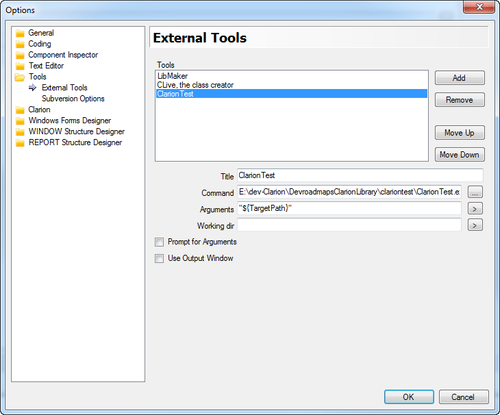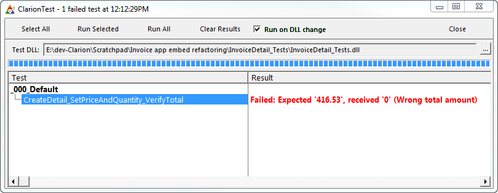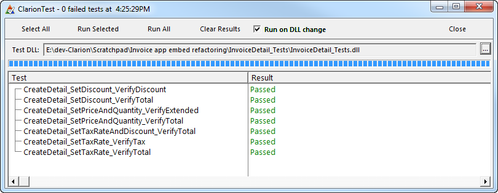The Problem With Embeds, Part 7: Unit Testing The InvoiceDetail Class
In Part 6 of this series I began rewriting some of the embed code from the UpdateDetail procedure in the Invoice app as a reusable, testable class. Although I simply showed some test code on its own, that code lives inside a ClarionTest-compatible test DLL.
If you're following along, read Creating a ClarionTest test DLL (DCL) for instructions on how to create a new test DLL.
The first test procedure
Click on New Procedure and add a procedure called CreateDetail_SetPriceAndQuantity_VerifyExtended.
In the Select Procedure Type dialog click on the Defaults tab and choose Test Procedure. Make sure you're on the Defaults tab, not the Templates tab!
You'll notice that the procedure properties have been preloaded with a prototype and parameters. Do not change these values or the test procedure will not work and may cause a GPF in ClarionTest or your DLL.
Now, right-click on the procedure and choose Source to bring up the Embeditor
There really are only two embeds you need to be concerned about in the test procedure. One is the data embed, where you declare any data you need for the test. The other is Priority 5000, right before the return statement. That's where you place your test code.
Here's the code for the data embed:
detail InvoiceDetail
And here's the code for the source embed:
detail.Init(12.50,3)
AssertThat(detail.GetExtended(),IsequalTo(37.50),'Wrong detail value')
Once you've entered the code your test procedure should look like this in the embeditor:
Save and compile the DLL. You'll get something like seven errors.
Clearly there's a problem because you haven't yet defined the class!
An easy way to create classes
There are a number of ways you can declare classes in Clarion; some of them are fraught with danger. For instance, if you create classes that you export from a DLL so they can be used elsewhere, you had better get everything just right or you'll probably be looking at GPFs.
For purposes of this article, I'll follow the approach I outlined in Quick starts for classes.
Using the Quick Starts described in that article (or by starting from scratch) create a file called InvoiceDetail.inc with the following contents:
InvoiceDetail Class,Type,module('InvoiceDetail.clw'),link('InvoiceDetail.clw',1)
GetExtended procedure,real
Init procedure(real price,long quantity)
End
Next create InvoiceDetail.clw:
member
map
end
include('InvoiceDetail.inc'),once
InvoiceDetail.GetExtended PROCEDURE
code
return 0
InvoiceDetail.Init procedure(real price,long quantity)
code
Now go back to the DLL APP file again. On the global embeds choose the After Global INCLUDEs embed point and insert the following source:Include('InvoiceDetail.inc'),once Save the embed.
You should now be able to compile the DLL.
Setting up ClarionTest
There's one more thing you should do now to make unit testing as painless as possible, and that's to set up ClarionTest in the Tools menu. Choose Tools | Options, and from the list of Options choose Tools again. Click on Add to create an new external tool entry. Set the Command field to point to ClarionTest.exe, and set the Arguments field to "${TargetPath}" as in Figure 8. You don't need the quotes if you will never have spaces in your path names.
With the test DLL as the active window in the IDE, choose Tools | Run unit tests. You should see the ClarionTest window with the test DLL loaded:
You'll notice that the procedure name is in all caps - that's how the symbol is exported from the DLL. The procedure name is reformatted after the test is run, based on information returned by the test.
Press the Run All button. You should see a test failure:
Figure 10. Test failure
GetExtended just returns zero. Change the class code to store the price and quantity in private variables, as follows:
Section('Header')
InvoiceDetail Class,Type
GetExtended procedure,real
Init procedure(real price,long quantity)
price real,PRIVATE
quantity long,PRIVATE
End
Section('Methods')
InvoiceDetail.GetExtended PROCEDURE
code
return self.price * self.quantity
InvoiceDetail.Init procedure(real price,long quantity)
CODE
self.price = price
self.quantity = quantityYes, I realize I'm using a real for the price - bear with me for a little while.
Compile the DLL.
If you exited the ClarionTest application, restart it from the Tools menu. If you still have it up run the test again - it should now pass. You can also tick the Run on DLL change box to have any currently selected tests run automatically whenever the DLL is rebuilt.
Now, how about getting the discount amount? That involves two things: setting a discount percentage rate and calculating the discount. Really there are two things to test: Is the discount amount right, and is the total right? Let's start with the discount amount.
Create a new procedure called CreateDetail_SetDiscount_VerifyDiscount. Select Test Procedure from the Template Types dialog, Defaults tab. Or just highlight the first test, press Ctrl-C, then type in the new name. That will save a bit of setup typing.
Change the test code in this new procedure to
detail.Init(11.45,3)
detail.SetDiscountRate(11)
AssertThat(detail.GetDiscount(),IsEqualTo(3.78),'Wrong discount amount')
The test uses a value of $11.45 and a discount of 11%. Plug that into your calculator and 3 * 11.45 * .11 = 3.7785. That's not an acceptable currency value; the test expects a rounded value of 3.78.
Again, the test won't compile because the GetDiscount and SetDiscountRate methods don't yet exist.
Add the declarations in the class header:
GetDiscount procedure,real SetDiscountRate procedure(real discountRate)
And the implementation of the method (I've set GetDiscount to return 0 as a default):
InvoiceDetail.GetDiscount procedure
code
return 0
InvoiceDetail.SetDiscountRate procedure(real discountRate)
code
self.discountRate = discountRate
Run the test - it fails, because there's no code to calculate the actual discount.
InvoiceDetail.GetDiscount PROCEDURE
code
return self.discountRate / 100 * self.GetExtended()
Unfortunately, even after implementing the method the test fails!
The test returns the unrounded value of 3.7785, which is a failure.
You could Round() the result, but a better solution is simply not to use floating point numbers for financial calculations! Floating point math is subject to small errors. Use decimal types instead which will invoke Clarion's Binary Coded Decimal (BCD) library, the recommended option for all calculations where errors are unacceptable. That means scrubbing the calculation of any Real values.
Here's an updated GetDiscount():
InvoiceDetail.GetDiscount PROCEDURE
Extended decimal(10,2)
Result decimal(10,2)
code
Extended = self.GetExtended()
Result = self.discountRate / 100 * Extended
return Result
I used to think that as long as you had at least one decimal field in a calculation that the BCD library would be invoked. But the help says this about addition, multiplication and subtraction:
Performed as a BCD operation when neither operand has a REAL Base Type (both are LONG or DECIMAL) and one has the DECIMAL Base Type.
and this about division:
Performed as a BCD operation when neither operand has a REAL Base Type (both are LONG or DECIMAL).
It seems the safe thing to do is to ensure that no reals are involved, which is why I've saved the returned value to a local variable. It is however safe to return the value as a real since no math is done at that point.
Another way to approach this is to have a calculation method that updates class properties each time some value changes - that would save storing a local copy prior to doing the calculation.
But why don't I just use decimals entirely, instead of reals anywhere? Mainly because decimals have to be passed by address and can't otherwise be a return value. I find that a bit clunky.
More tests
Here are the rest of the tests, which while not yet exhaustive do a reasonable job of covering the bases. You can find them in InvoiceDetail_Tests.app in the source download.
Here's the completed class header:
InvoiceDetail Class,Type,module('InvoiceDetail.clw'),link('InvoiceDetail.clw',1)
GetDiscount procedure,real
GetExtended procedure,real
GetSavings procedure,real
GetTax procedure,real
GetTotal procedure,real
Init procedure(real price,long quantity)
SetDiscountRate procedure(real discountRate)
SetTaxRate procedure(real taxRate)
price decimal(10,2),PRIVATE
discountRate decimal(5,2),private
quantity long,PRIVATE
taxRate decimal(5,2),private
End
And the method source:
include('InvoiceDetail.inc'),once
InvoiceDetail.GetDiscount PROCEDURE
Extended decimal(10,2)
Result decimal(10,2)
code
Extended = self.GetExtended()
Result = self.discountRate / 100 * Extended
return Result
InvoiceDetail.GetExtended PROCEDURE
code
return self.price * self.quantity
InvoiceDetail.GetSavings PROCEDURE
code
return self.GetDiscount()
InvoiceDetail.GetTax procedure
result decimal(10,2)
Extended decimal(10,2)
Discount decimal(10,2)
code
Extended = self.GetExtended()
Discount = self.GetDiscount()
result = self.taxRate / 100 * (Extended - Discount)
return result
InvoiceDetail.GetTotal PROCEDURE
code
return self.GetExtended() - self.GetDiscount() + self.GetTax()
InvoiceDetail.Init procedure(real price,long quantity)
code
self.price = price
self.quantity = quantity
InvoiceDetail.SetDiscountRate procedure(real discountRate)
code
self.discountRate = discountRate
InvoiceDetail.SetTaxRate procedure(real taxRate)
code
self.taxRate = taxRate
Implementing the class
Adding the class to the Invoice app is the same as adding it to the test DLL: just add the global include statement:
Include('InvoiceDetail.inc') And in the UpdateDetail procedure, add this line in the data section:
detail InvoiceDetail
Then, in the CalcValues routine, replace the existing embed code with this code:
detail.Init(DTL:price,DTL:QuantityOrdered)
detail.SetTaxRate(DTL:TaxRate)
detail.SetDiscountRate(DTL:DiscountRate)
DTL:TaxPaid = detail.GetTax()
DTL:Discount = detail.GetDiscount()
DTL:TotalCost = detail.GetTotal()
DTL:Savings = detail.GetSavings()You could create an overloaded Init() method to take the tax and discount rates as well, and reduce this code from seven lines to five. I tend not to go for methods with a large number of parameters unless all are necessary.
To update the totals on each change (including spin box clicks) I moved the do CalcValues call to the window's TakeEvent call.
File locations
You'll also have to put the InvoiceDetail.clw file somewhere it can be found. That means either putting it in a directory that's already listed in the redirection file (such as the Clarion libsrc directory) or updating the redirection file. You may want to set up a source directory for just your own classes.
In the downloadable source you'll see that I've added a Clarion80.red file to the InvoiceDetail_Tests and Invoice directories. Since both these apps share the InvoiceDetail.* files I chose to put them in a common location: the libsrc directory.
The Clarion80.red files are quite short. They include the standard Clarion80.red file and add a directive for the ..\libsrc directory:
{include %Root%\BIN\Clarion80.RED}
[Common]
*.* = ..\libsrc;
Summary
The original routine contained a hodgepodge of untestable, difficult to reuse code tied directly to a particular database.
The class that replaces that code isn't tied to any one database, can be reused easily without duplicating any business logic, and has an accompanying test suite to verify its behavior.
Extracting embed code into testable, reusable classes does involve some work, but the payoff is huge. You get verifiable code, and not just in the development phase. You can make changes to the class with much less risk of breaking existing code. If your unit tests are comprehensive, they'll catch any errors introduced by enhancements or even other bug fixes.
If you're using NetTalk, I'm told you need to add the "Suppress NetTalk" global extension in the test DLL.






